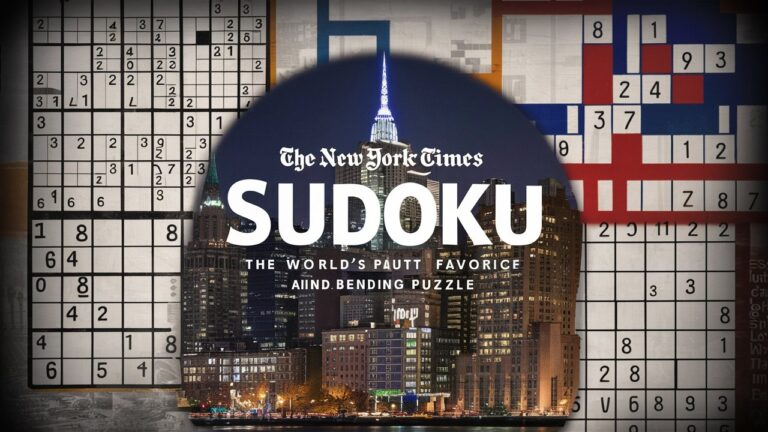Introduction: The Allure of Sudoku and the NYT Legacy
Sudoku, the deceptively simple number puzzle, has captivated millions worldwide since its rise to global prominence in the early 2000s. At the heart of this phenomenon lies The New York Times Sudoku, a benchmark for quality and challenge in the puzzle community. What began as a humble Japanese logic game has evolved into a daily ritual for enthusiasts who crave mental stimulation. The NYT Sudoku stands out not only for its meticulous design but also for its integration into the broader culture of puzzle-solving. This article explores the history, strategies, and cultural impact of the New York Times Sudoku, offering insights for both novices and seasoned solvers.
The History of Sudoku: From Japan to Global Sensation
Though often associated with Japanese culture, Sudoku’s origins trace back to a 1979 American puzzle called “Number Place.” It gained traction in Japan in the 1980s under the name Sudoku (short for sūji wa dokushin ni kagiru, meaning “numbers must be single”). The puzzle’s global explosion came in 2004 when British puzzle editor Wayne Gould convinced The Times of London to publish it. By 2005, The New York Times had adopted Sudoku, cementing its status as a mainstream intellectual pastime. The NYT Sudoku quickly became a gold standard, renowned for its escalating difficulty—from “Easy” to “Devilish”—and its seamless integration into the newspaper’s iconic crossword app.
Why the New York Times Sudoku Stands Out
The NYT Sudoku distinguishes itself through rigorous editorial standards and a commitment to accessibility and challenge. Each puzzle undergoes meticulous testing to ensure logical solvability without guesswork. The NYT app enhances the experience with features like error-checking, hints, and timed challenges, catering to both casual players and competitive solvers. Additionally, the NYT’s daily Sudoku is part of a broader puzzle ecosystem that includes crosswords and Spelling Bee, fostering a community of dedicated solvers. The puzzles’ difficulty progression—Monday (easiest) to Saturday (hardest)—encourages skill development, making it a favorite for long-term engagement.
Cognitive Benefits of Solving Sudoku Regularly
Beyond entertainment, Sudoku offers measurable cognitive benefits. Studies suggest that regular puzzle-solving improves memory, enhances problem-solving skills, and may delay cognitive decline. The NYT Sudoku’s structured difficulty levels provide a mental workout akin to weight training: simpler puzzles build foundational logic skills, while complex grids demand advanced pattern recognition. Neuroscientists note that Sudoku activates the prefrontal cortex, responsible for decision-making and focus, making it a valuable tool for maintaining mental agility. For many, the daily NYT Sudoku is both a meditation and a brain-boosting habit.
Mastering Advanced Strategies: Tips for Conquering Devilish Puzzles
To tackle the NYT Sudoku’s toughest grids, solvers must move beyond basic techniques like “pencil marking” and embrace advanced strategies. Methods such as X-Wing (identifying paired candidates across rows/columns) and Swordfish (extending X-Wing logic to three rows/columns) help eliminate possibilities in complex scenarios. Another tactic, Skyscraper, uses chain logic to uncover hidden number placements. The NYT’s hardest puzzles often require “what-if” reasoning, where solvers temporarily assume a number’s placement to test contradictions. Mastery comes with practice, and the NYT app’s archive of past puzzles serves as a treasure trove for honing skills.
The Role of the NYT Sudoku in Building a Puzzle Community
The New York Times has cultivated more than a puzzle—it’s fostered a global community. Online forums, social media groups, and competitive leaderboards connect solvers who share tips, celebrate victories, and commiserate over stumbles. The NYT’s annual Sudoku tournaments and collaborations with puzzle constructors like Will Shortz (the newspaper’s longtime puzzle editor) further deepen this camaraderie. For many, completing the daily Sudoku is a shared ritual, bridging generations and geographies. The puzzle’s universal language of numbers transcends barriers, making it a unifying force in an increasingly fragmented world.
Frequently Asked Questions (FAQs)
- How does the NYT Sudoku differ from free online puzzles?
The NYT Sudoku is curated for quality and consistency, with each puzzle tested for uniqueness and logical solvability. Free puzzles often vary in difficulty and may contain errors. The NYT also offers integrated features like progress tracking and expert commentary. - What’s the best way to improve at solving harder Sudoku puzzles?
Practice consistently, starting with easier grids to build confidence. Learn advanced techniques like “hidden pairs” and “coloring,” and use the NYT app’s hint system to identify missed strategies. - Are NYT Sudoku puzzles computer-generated?
No. While computers can generate Sudoku grids, the NYT puzzles are handcrafted by editors to ensure a satisfying solve path and balanced difficulty. - Can I access past NYT Sudoku puzzles?
Yes. The NYT Crossword app archives previous puzzles, allowing unlimited access for subscribers. - Is there a time limit for completing the daily Sudoku?
While the app tracks solve times, there’s no enforced limit. Solvers can take as long as needed—though speedruns are popular among competitive players!
Conclusion: The Timeless Appeal of the NYT Sudoku
The New York Times Sudoku is more than a puzzle; it’s a testament to the enduring power of logic and patience. Its blend of simplicity and depth resonates with solvers of all ages, offering a daily escape into a world of numbers and patterns. As technology advances and attention spans wane, the NYT Sudoku remains a steadfast reminder of the joy found in focused, deliberate thinking. Whether you’re a newcomer or a veteran, the puzzle invites you to sharpen your mind, one grid at a time.
Ready to start your Sudoku journey? Visit The New York Times Games platform and join millions in the ultimate test of logic and perseverance.
